![]()
![]()
![]()
Use LEFT and RIGHT arrow keys to navigate between flashcards;
Use UP and DOWN arrow keys to flip the card;
H to show hint;
A reads text to speech;
33 Cards in this Set
- Front
- Back
|
mycorrhizae
|
symbiotic fungi
|
|
|
mycology.
|
study of fungi
|
|
|
Fungi cell type
|
Eukaryotic
|
|
|
Cell Membrane
|
Sterols present
|
|
|
Fungi cell wall
|
Glucans; mannans; chitin (no peptidoglycan)
|
|
|
Glucan
|

a polysaccharide of D-glucose monomers linked by glycosidic bonds.
|
|
|
Mannan
|
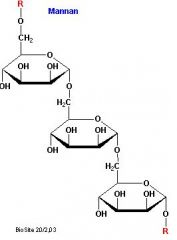
plant polysaccharide that is a polymer of the sugar mannose
|
|
|
Chitin
|
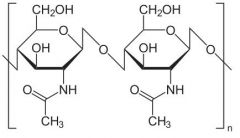
long-chain polymer of a N-acetylglucosamine, a derivative of glucose.
|
|
|
thallus
|
body of a fungus
|
|
|
hyphae
|
filaments of a cell that make up the thallus
|
|
|
septa
|
cross walls of hyphae that divide them into distinct uni-nucleate units
|
|
|
Types of Hypha
|
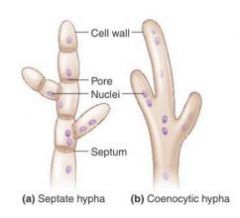
|
|
|
portion of a hypha that obtains nutrients
|
vegetative hypha
|
|
|
portion of the hypha concerned with reproduction
|
reproductive or aerial hypha
|
|
|
When environmental conditions are suitable, the name of the filamentous mass which is visible to the unaided eye
|
mycelium
|
|
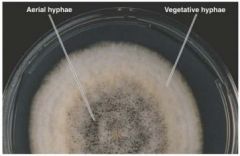
|
aerial: reproductive portion
vegetative: nutrient obtaining part |
|
|
Yeast attributes
|
-nonfilamentous, unicellular fungi
-oval |
|
|
Budding yeasts
|
Divide unevenly
|
|
|
pseudohypha
|
yeasts that produce buds that fail to detach them-selves; form a short chain of cells
|
|
|
Fission yeasts
|
divide evenly to produce two new cells
|
|
|
yeast products with oxygen
|
carbon dioxide and water
|
|
|
yeast products without oxygen
|
ethanol and carbon dioxide
|
|
|
dimorphism
|
-Two forms of growth
-Fungi that can grow either as a mold or as a yeast -effected by temperature or CO2 concentration |
|
|
spores
|
formed from aerial hyphae in a number of different ways, depending on the species
asexual or sexual |
|
|
Asexual spores
|
formed from the hyphae of one organism
|
|
|
Sexual spores
|
result from the fusion of nuclei from two opposite mating strains of the same species of fungus
|
|
|
Asexual spores
|
produced by an individual
fungus through mitosis and subsequent cell division; there is no fusion of the nuclei of cells. |
|
|
conidiospore
|
a unicellular or multicellular spore that is not enclosed in a sac
|
|
|
Two types of asexual fungi
|
-conidiospore
-sporangiospore |
|
|
conidiospore
|
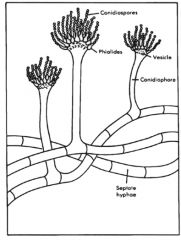
|
|
|
sporangiospore
|

|
|
|
Three phases of Sexual spores in Fungi
|
I. Plasmogamy. A haploid nucleus of a donor cell (+)
penetrates the cytoplasm of a recipient cell (-). 2. Karyogamy. The (+) and (-) nuclei fuse to form a diploid zygote nucleus. 3. Meiosis. The diploid nucleus gives rise to haploid nuclei (sexual spores), some of which may be genetic recombinants. |
|
|
Fungi advantages over bacteria
|
-fungi grow better in pH of 5
-most modes are aerobic, most yeasts are facultative anaerobes -most fungi are resistant to osmotic pressure (will grow in sugar and salt environments) -Fungi can grow on low moisture content substances -Fungi require less nitrogen -Fungi can metabolize complex carbohydrates |

